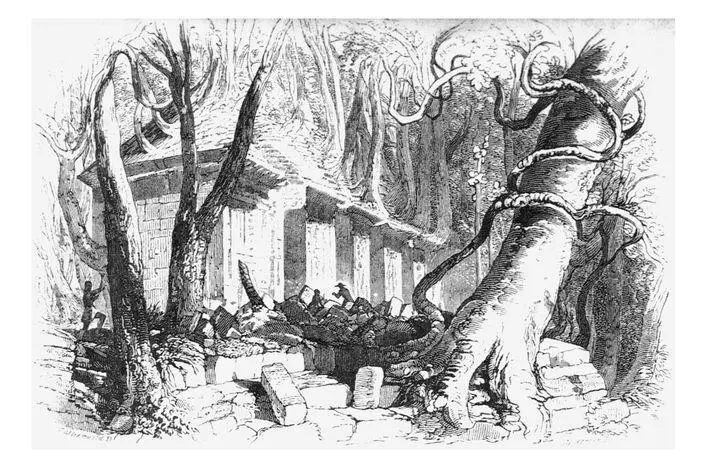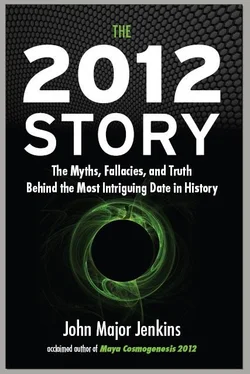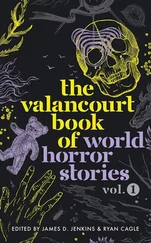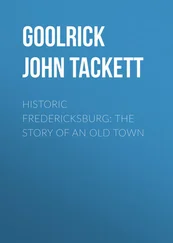It was filled with commentaries in Latin, Hebrew, Greek, and Sanskrit supporting the idea, which Kingsborough had lifted from las Casas, that the Maya descended from the Lost Tribes of Israel. This idea became a point of theological doctrine for the Mormons, whose archaeologists have done impressive scientific work at early Maya sites in southern Mexico. Kingsborough’s obsession got him into trouble, as his lavishly produced volumes put him in debt. The handmade paper he had chosen for his opus were more than he could afford. Sadly, he died of typhus in a debtors’ prison in Ireland, a circumstance that caused the British Museum to purge his name from its catalog, listing Kingsborough’s work instead under the name of Aglio, his hired artist.
EXPLORERS AND LOST CITIES
Mexico was often accessed by travelers landing in Veracruz or Acapulco. But the Maya heartland lay far to the east, and the remnants of the ancient civilization of the Maya, more distantly remote in time than the Aztecs, were off the beaten path and had largely escaped the attention of travelers. Nevertheless, rumors of what lay hidden in the thick jungles of the east began reaching the ears of adventurers, including a colorful character named Count Waldeck.
Antonio Del Rio visited Palenque when it was very difficult to reach. He managed to publish his account in 1822, and to illustrate his book his London publisher hired a man named Jean-Frédéric Maximilien de Waldeck. An artist, traveler, and womanizer, Waldeck was so intrigued with Del Rio’s story of a lost city in the jungles of Mexico that, at age fixty-six, he crossed the ocean to see it for himself. While insinuating himself into society circles in Mexico City, doing portraits while seeking funds for his expedition to Palenque, Waldeck claimed to have been close friends with Lord Byron and Marie Antoinette. Eventually, the self-described count spent an entire year in the village of Santo Domingo near Palenque, plus four months in a hut he built in the shadows of Palenque’s crumbling tower. Joining him during his tenure studying the ruins was a young mestizo woman who probably provided some incentive for staying in that sweltering, bug-infested place. In these inhospitable circumstances he produced some ninety drawings, striking in their artful execution but deceiving in their embellished details.
After Palenque he went to the sites of Yucatán and made more drawings, escaping to London when he found out that the local authorities thought he was a spy. His drawings narrowly avoided being seized. Discovering that government officials were suspicious of his activities, he quickly copied the entire lot of drawings and let them seize the copies, while the originals were safely hidden away. His ruse made further searches of his belongings unnecessary. With his pictographic booty in hand, he published a selection of twenty-one plates with a hundred pages of text, in which he elaborated his theory that Palenque was built by Chaldeans and Hindus. Considering that no one had any clue as to when the Maya cities were built and lived in, Waldeck’s estimate for Palenque’s demise (600 AD) was surprisingly accurate. His book was immensely pricey, some $1,500 apiece in today’s dollars, apparently intended for nobles and counts like himself. Waldeck had accomplished what he set out to do, and he did it in his characteristic roguish style. For all we know, descendants of Waldeck are living in Palenque’s environs today.
By the late 1830s, many explorers had crisscrossed Anahuac (Mexico), looking for and finding evidence of many layers of ancient civilizations and fragments of a lost calendar. But for most outsiders—Europeans as well as people in the quickly expanding United States—Mexico and Central America were still seen as hot, disease-ridden, and uncivilized places best avoided. Two explorers were to change everything, and the world was ready to receive what they had to share.
In 1838, John Lloyd Stephens flipped through Waldeck’s book in Bart lett’s bookstore in New York City. Already a seasoned traveler at age thirty-two, having just written the critically acclaimed Travels in Egypt and Arabia Petraea (1837), Stephens was inspired, despite Waldeck’s reputation as an embellisher, to mount his own expedition to Central America. He invited a British acquaintance, artist Frederick Catherwood, to join him and document their findings. Their trip took place prior to photography becoming practical, but the detailed drawings Catherwood produced exceeded in quality anything produced by photography for another four decades.
Stephens had helped elect president Martin Van Buren, and through his office he secured an appointment: He would be U.S. Diplomatic Agent to the Republic of Central America. Despite the flimsy status of such a republic, his title and official-looking papers would help him navigate uncharted territories where governments rose and fell with the seasons. In October of 1839, they sailed from New York. Landing in Belize, they followed the reports of one Juan Galindo and ascended the Motagua River into Guatemala before turning south to cross a range of mountains, making a beeline for the rumored lost city that we now call Copán. Their trip was just beginning. Malaria, bandits, and civil wars were a constant threat, and would be over the next three months and 5,000 miles.
The sun barely pierced the heavy jungle canopy, but the oppressive heat of midday smothered everything. Three mules labored and slid on the muddy trail, burdened with packs, canvasses, and provisions. The two men patiently followed behind, swatting bugs while looking intently through the foliage, trying to spot the telltale signs of lost temples—an oddly placed stone, a cockeyed carving, rock walls hulking through the shadowy arboretum. On November 17, 1839, they entered Copán. Stephens later recalled, understating the surprise they really felt: “I am entering abruptly upon new ground.” 14
So began a new era in the exploration and recovery of the Maya civilization. After weeks of clearing away debris from temple stairways and platforms, Catherwood carefully making dozens of drawings, they realized they had barely scratched the surface. Stephens, realizing the importance of the site, purchased it from the rightful owner for $50. Anxious to get to Palenque, they set out across the mountains of Guatemala, down the Usumacinta River valley, and through the Lacandon rain forest, a journey of more than three hundred miles.

Palenque in 1840. Drawing by Frederick Catherwood
Arriving at Palenque, Stephens and Catherwood saw with their own eyes that Waldeck and Del Rio had not been exaggerating. By happenstance, another expedition, led by Walker and Caddy, had just visited and left Palenque. These kinds of close calls would occur time and again in the “discovery” of lost cities. Palenque, however, was never lost to the locals, although for centuries the stones languished half forgotten—and were often pillaged as a resource for good building stone.
Stephens and Catherwood continued their journey by visiting the extensive sites of the Yucatán peninsula. Labna, Uxmal, and the awe-inspiring site of Chichén Itzá topped their list of sites they explored and documented. From a man in Mérida Stephens learned about the dot and bar numeration that could be clearly seen in the glyphs. He could thus get a rudimentary handle on numerology in the Long Count dates, for a bar represented 5 and a dot represented 1. He duly reported these things in his engaging though somewhat dry travelogue, stoking the curiosity of many readers for years to come. Incidents of Travel in Central America and Yucatan , published and priced af fordably in 1841, was a huge success. It has remained in print to this day.
Читать дальше













